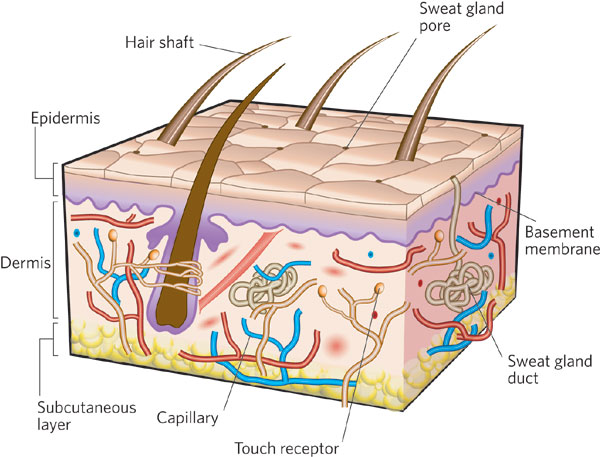
The Skin is an ever-changing organ that contains many specialized cells and structures. The skin functions as a protective barrier that interfaces with a sometimes-hostile environment. It is also very involved in maintaining the proper temperature for the body to function well. It gathers sensory information from the environment, and in plays an active role in the immune system protecting us from disease. Understanding how the skin can function in these many ways starts with understanding the structure of the 3 layers of skin - the epidermis, dermis and subcutaneous tissue.
Epidermis
The epidermis is the outer layer of skin. The thickness of the epidermis varies in different types of skin. It is the thinnest on the eyelids at .05 mm and the thickest on the palms and soles at 1.5 mm.
The epidermis contains 5 layers.
The top layer of the epidermis, the stratum corneum, is made of dead, flat skin cells that shed about every 2 weeks.
Dermis
The dermis also varies in thickness depending on the location of the skin. It is .3 mm on the eyelid and 3.0 mm on the back. The dermis is composed of three types of tissue that are present throughout - not in layers. The types of tissue are:
- collagen
- elastic tissue
- reticular fibers
Specialized Dermal Cells
The dermis contains many specialized cells and structures.
- The hair follicles are situated here with the erector pili muscle that attaches to each follicle.
- Sebaceous (oil) glands and apocrine (scent) glands are associated with the follicle.
- This layer also contains eccrine (sweat) glands, but they are not associated with hair follicles.
- Blood vessels and nerves course through this layer. The nerves transmit sensations of pain, itch, and temperature.
- There are also specialized nerve cells called Meissner's and Vater-Pacini corpuscles that transmit the sensations of touch and pressure.
Subcutaneous Tissue
The subcutaneous tissue is a layer of fat and connective tissue that houses larger blood vessels and nerves. This layer is important is the regulation of temperature of the skin itself and the body. The size of this layer varies throughout the body and from person to person.
Functions of the skin
As you can see, there are many different structures within the skin. Together these structures impart many protective properties to the skin that help avoid damage to the body from outside influences. In this way, the skin:
- protects the body from water loss and from injury due to bumps, chemicals, sunlight or microorganisms (‘germs’);
- helps to control body temperature;
- is a sensor to inform the brain of changes in the immediate environment; and
- synthesises vitamin D.
Information obtained from: http://dermatology.about.com/cs/skinanatomy/a/anatomy.htm